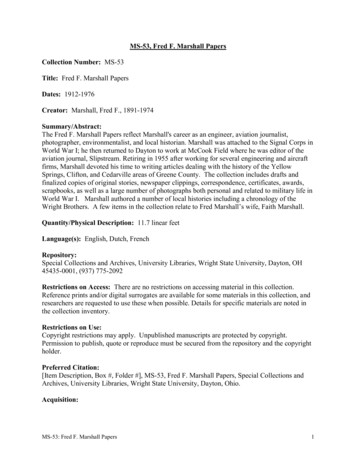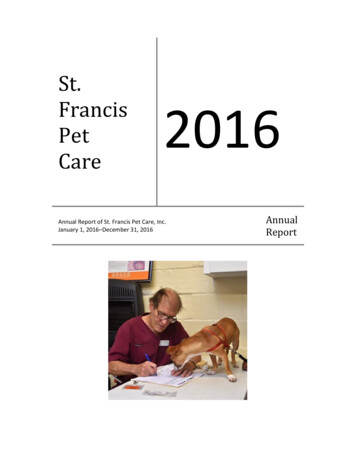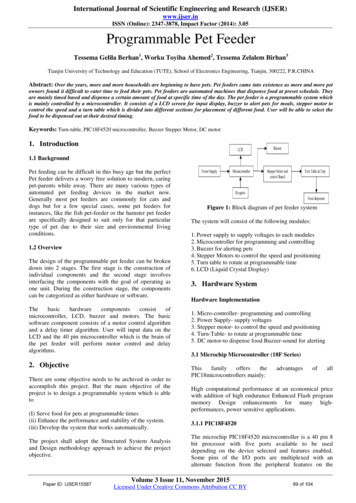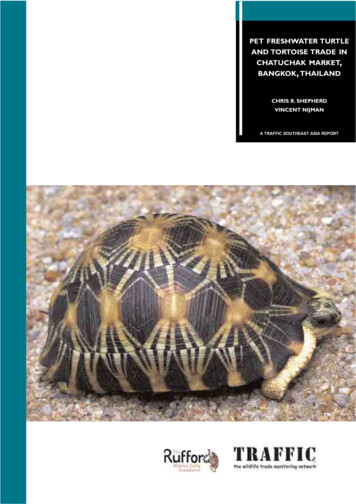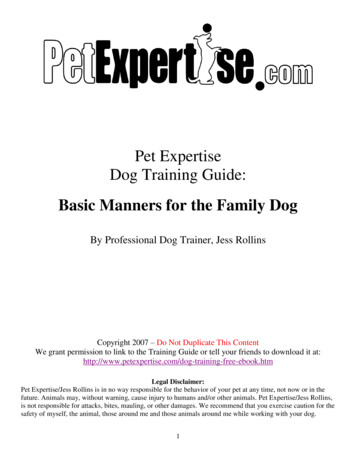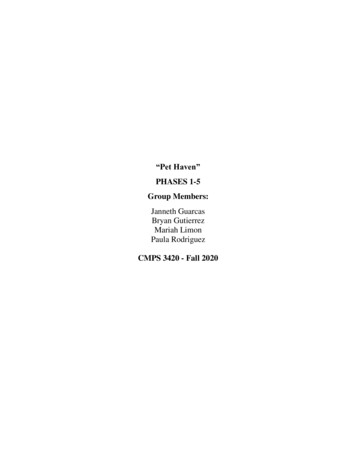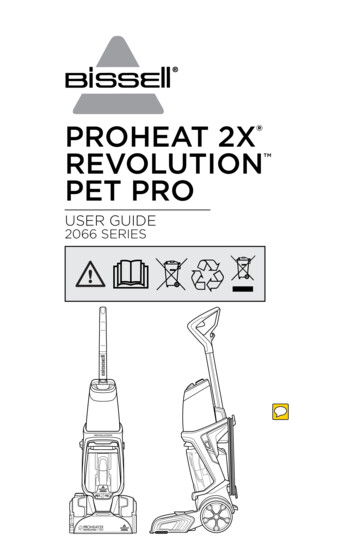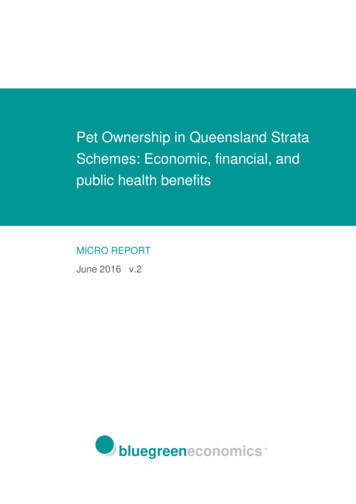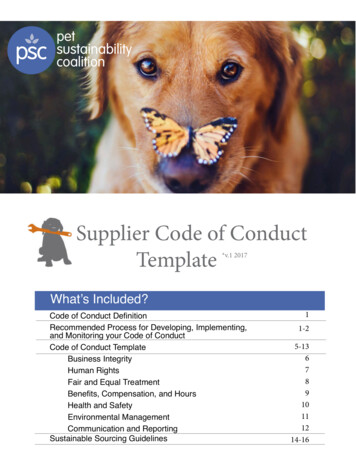
Transcription
pET System ManualTable of ContentsI. About the System3A. DescriptionB. Licensing and Use AgreementC. System ComponentsD. The pET VectorsVector Characteristics and Cloning StrategyLigation-Independent Cloning (LIC) of PCR ProductsFusion TagsE. Antibiotic ResistanceF. pET Vector CharacteristicsG. Hosts for CloningH. Hosts for ExpressionpET System Host Strain CharacteristicsI. Selecting Host StrainsList of pET System Host Strains and Lambda PhagesJ. Media Containing GlucoseK. The T7lac PromoterL. pLysS and pLysE HostsM. Bacteriophage CE6N. Induction ControlsII. Getting Started3334445678891011121212131415A. The pET System ProcessB. Growth MediaC. Storage of StrainsD. Vector PreparationRecommendationsE. Insert Preparation151617171819III. Cloning Inserts in pET Vectors20A. LigationB. TransformationHandling TipsProcedurePlating TechniqueC. Analysis of pET RecombinantsTranscription/Translation Analysis of PCR Products with STP3 Ligation PCR for STP3 AnalysisColony PCR for STP3 AnalysisColony ScreeningPlasmid Miniprep ProcedureSequencingIV. Expressing the Target GeneA. Expression Host TransformationB. Induction of λDE3 LysogensPreparation for InductionSample Induction ProtocolC. Optimizing ExpressionPlasmid Stability TestD. SolubilityFormation of Disulfide Bonds: pET-32, pET-39 and pET-40E. Toxic Genes and Plasmid InstabilityUse of AmpicillinPrecautions to Maximize ExpressionRationale for Plasmid Stability TestUnited States & CanadaOrders: 800 526-7319Technical Service: 800 207-0144TB055 8th Edition 93030Novagen1
pET System ManualF. Difficult Target ProteinsOther Factors Influencing Expression LevelV. Detecting and Quantifying Target ProteinsDetection/Assay Products for Fusion TagsVI. Purifying Target Proteins3132333334A. Small Scale AnalysisGrowth and InductionOptical Density Analysis of the Induced CultureTotal Cell Protein (TCP) SampleMedia SamplePeriplasmic Fraction Sample–Osmotic ShockSoluble Cytoplasmic FractionInsoluble Cytoplasmic FractionB. Preparation of Cell Extracts with BugBuster Protein Extraction ReagentSoluble FractionInclusion Body PurificationC. SDS-PAGE and Western Blot AnalysisNormalized SDS-PAGE Gel LoadingD. Large Scale Induction and FractionationMedia FractionPeriplasmic FractionSoluble Whole Cell Extract FractionInsoluble Whole Cell Extract Fraction–Isolation of Inclusion BodiesSolubilization of Inclusion Bodies and Refolding ProteinsPurification Products for Affinity TagsVII. Induction Control: β-Galactosidase Recombinantβ-Galactosidase III. Acknowledgments46IX. References46X. Index48XI. Academic and Non-profit Laboratory Assurance Letter50Copyright 1992–1999 by Novagen, Inc. All rights reserved.CBD Tag, T7 Tag, His Tag, His Bind, NovaTope, S Tag, Trx Tag, Dsb Tag, GST Tag, GST Bind, pSCREEN, HSV Tag, Strandase, Pellet Paint,pCITE, Perfect Protein, Perfect DNA, Single Tube Protein, STP3, EXlox, Red Nova, Singles, Clonables, LumiBlot, Xarrest, EKapture,BugBuster, the Novagen name and logo are trademarks and registered trademarks of Novagen, Inc.The pET system is covered by U.S. Patent no. 4,952,496. A non-distribution agreement accompanies the products. Commercial customers mustobtain a license agreement from Brookhaven Science Associates before purchase. The pET-32 vectors are sold under patent license fromGenetics Institute, Inc. For research use only. Licenses for commercial manufacture or use may be obtained directly from Genetics Institute,Inc., 87 Cambridge Park Drive, Cambridge, MA 02140. The CBD Tag technology is covered under U.S. Patent nos. 5,496,934; 5,202,247;5,340,731; and 5,137,819. Use of this technology for commercial purposes requires a license from CBD Technologies, Inc. The GST Tagtechnology is covered under U.S. Patent no. 5,654,176, European Patent no. 293,249B1, and Australian Patent no. 607,511.Novagen’s primers are designed and sold for use in the Polymerase Chain Reaction (PCR) process covered by patents owned by Hoffmann-LaRoche. Use of the PCR process requires a license. A license for research may be obtained by purchase and use of authorized reagents and DNAthermal cyclers from the Perkin-Elmer Corporation or by otherwise negotiating a license with Perkin-Elmer.CBIND is a trademark of CBD Technologies, Inc.2NovagenTB055 8th Edition 02/99United States & CanadaOrders: 800 526-7319Technical Service: 800 207-0144
pET System ManualI. About the SystemA. DescriptionTo get started quickly, moveahead to page 15.The pET System is the most powerful system yet developed for the cloning and expression ofrecombinant proteins in E. coli. Target genes are cloned in pET plasmids under control of strongbacteriophage T7 transcription and (optionally) translation signals; expression is induced byproviding a source of T7 RNA polymerase in the host cell. T7 RNA polymerase is so selective andactive that almost all of the cell’s resources are converted to target gene expression; the desiredproduct can comprise more than 50% of the total cell protein a few hours after induction. Anotherimportant benefit of this system is its ability to maintain target genes transcriptionally silent inthe uninduced state. Target genes are initially cloned using hosts that do not contain the T7 RNApolymerase gene, thus eliminating plasmid instability due to the production of proteinspotentially toxic to the host cell (see Section I.G. for details). Once established in a nonexpression host, plasmids are then transferred into expression hosts containing a chromosomalcopy of the T7 RNA polymerase gene under lacUV5 control, and expression is induced by theaddition of IPTG. Two types of T7 promoter and several hosts that differ in their stringency ofsuppressing basal expression levels are available, providing great flexibility and the ability tooptimize the expression of a wide variety of target genes.All of the pET vectors and companion products are available as kits designed for convenientcloning, expression, detection, and purification of target proteins. The pET system provides thecore reagents needed. The background information following System Components will help youdetermine the best vector/host combination for your application.B. Licensing and Use AgreementThis T7 expression system, including bacteria, phages, and plasmids that carry the gene for T7RNA polymerase, is made available under the conditions listed in the Academic and Non-profitLaboratory Assurance Letter. Please refer to the complete list of conditions on the last page ofthis manual or in the letter received with your kit.C. System ComponentspET Expression Systems provide core reagents needed for target gene cloning and expression. A good way to distinguishglycerol stocks from competentcells: glycerol stocks aresupplied in screw-top tubes;competent cells have a flip top.12pET vector DNA, 10 µg each of the indicated plasmids1, 2Host bacterial strains BL21, BL21(DE3) and BL21(DE3)pLysS, glycerol stocksInduction control clone, glycerol stockNovagen Vector Diskette containing all vector sequences (compatible with Macintosh andDOS/Windows)Systems plus Competent Cells contain a set of three host strains ready for high-efficiencytransformation of pET recombinants. These kits include the following additional components,which are sufficient for up to 10 transformations in each host: One 0.2 ml aliquot of each host NovaBlue, BL21(DE3) and BL21(DE3)pLysS as pretestedcompetent cells SOC medium Test PlasmidThe pET Peptide Expression System 31 includes host strains BLR and BLR(DE3)pLysS in place of the BL21 series hosts.The pET Trx Fusion System 32 includes AD494 series hosts strains in addition to the BL21 series hosts.United States & CanadaOrders: 800 526-7319Technical Service: 800 207-0144TB055 8th Edition 02/99Novagen3
pET System ManualComponents available separately:ProductSizeCat. No.pET Vector DNA*pET Host Strains & Competent Cellssee p. 11Novagen Vector Diskette69447* Please refer to the Novagen catalog or www.novagen.com for a complete list.D. The pET VectorsThe pET vectors were originally constructed by Studier and colleagues (Studier and Moffatt,1986; Rosenberg et al., 1987; Studier et al., 1990). The newer pET derivatives developed atNovagen were designed with enhanced features to permit easier subcloning, detection, andpurification of target proteins. Two general categories of vectors are available: transcription andtranslation vectors. Transcription vectors are designed for expression of target genes that already carry their ownprokaryotic ribosome binding site and ATG start codon. Translation vectors contain the highly efficient ribosome binding site from the phage T7 majorcapsid protein.The translation vector names are distinguished from the transcription vector names by theaddition of a letter suffix following the name, e.g., pET-21a( ), which denotes the readingframe relative to the BamH I cloning site recognition sequence, GGATCC. All vectors with thesuffix “a” express from the GGA triplet, all vectors with the suffix “b” express from the GATtriplet, and all vectors with the suffix “c” express from the ATC triplet of the BamH Irecognition sequence.Vectors with a “d” suffix also express from the “c” frame, but contain an upstream Nco Icloning site in place of the Nde I site in that series for insertion of target genes directly into theATG start codon.Vector Characteristics and Cloning StrategyIn general, translation vectors are used for the expression of target genes derived from eukaryoticsources, and transcription vectors are used for target genes derived from prokaryotic genes(which usually carry compatible ribosome binding sites).Many strategies can be used for subcloning a protein-coding region of DNA into a pET vector forexpression. The most convenient strategy is to use the unique restriction sites found in themultiple cloning region of the pET vectors for cloning inserts in a defined orientation using twodifferent sites.Ligation-Independent Cloning (LIC) of PCR ProductsAnother convenient method that does not require restriction digestion is the ligation-independentcloning (LIC) method. Ligation-independent cloning was developed for the directional cloning ofPCR products without restriction enzyme digestion or ligation reactions (Aslanidis and de Jong,1990; Haun et al., 1992). LIC vectors are created by treating a linearized backbone with T4 DNApolymerase in the presence of only one dNTP. The 3' 5' exonuclease activity of T4 DNApolymerase removes nucleotides until it encounters a residue corresponding to the single dNTPpresent in the reaction mix. At this point the 5' 3' polymerase activity of the enzyme counteractsthe exonuclease activity to effectively prevent further excision. Plasmid sequences adjacent tothe site of linearization are typically designed to produce specific non-complementary 12 to 14base single stranded overhangs in the LIC vector. Compatible inserts with complementaryoverhangs are generated by building appropriate 5' extensions into the primers. The PCR productis purified to remove dNTPs (and original plasmid if it was used as template) and then treatedwith T4 DNA polymerase in the presence of the appropriate dNTP to generate the specific vectorcompatible overhangs. Cloning is very fast and efficient because only the desired product isformed by annealing. The annealed LIC vector and insert are transformed into competent E. colicells. Covalent bond formation at the vector-insert junctions occurs within the cell to yieldcircular plasmid.4NovagenTB055 8th Edition 02/99United States & CanadaOrders: 800 526-7319Technical Service: 800 207-0144
pET System ManualNovagen offers LIC vectors as linearized, LIC-modified DNA in which the LIC overhang encodesan enterokinase or Factor Xa cleavage site. The vectors are designed to enable the removal of allvector-encoded sequence from the expressed fusion protein upon cleavage with these proteases.Kits include LIC Vector, annealing reagents and competent cells (NovaBlue Singles , BL21(DE3)and BL21(DE3)pLysS).pET LIC Vector KitsSizeCat. No.pET Ek/LIC Vector KitspET-30 Ek/LIC Vector KitpET-32 Ek/LIC Vector KitpET-34 Ek/LIC Vector KitpET-36 Ek/LIC Vector KitpET Ek/LIC Combo Kit20 rxn20 rxn20 rxn20 rxn40 rxn69077-369076-370114-370145-370255-3pET Xa/LIC Vector KitspET-30 Xa/LIC Vector KitpET-32 Xa/LIC Vector KitpET-35 Xa/LIC Vector KitpET-37 Xa/LIC Vector Kit20 rxn20 rxn20 rxn20 rxn70073-370072-370115-370153-3Fusion TagsAlmost all of the pET vectors can express proteins that do not contain vector-encoded sequences.An Nde I or Nco I site is available in many vectors for cloning into the AUG start codon at the 5'end of the insert coding sequence. Similarly, proteins without vector-encodedC-terminal fusions are obtained by including a translation stop codon in the insert.However, various pET vectors also contain different sequences adjacent to the cloning sites thatencode a number of peptide “tags”, which perform various functions when fused with the targetprotein. Some of the fusion tags facilitate detection and purification of the target protein,whereas others increase the probability of biological activity by affecting solubility in thecytoplasm or export to the periplasm. The choice of cloning sites and strategies depends on thecombination of tags desired, and the location of tags on the N-terminus, C-terminus, or both endsof the target protein. The various fusion tags and the vectors that carry them are summarized inthe table on p. 6. It should be noted that the expression of desired C-terminal fusions requires (1)the lack of a stop codon in the insert, and (2) the proper reading frame at the cloning junction.Except for the pET-5 series, all of the pET vectors contain translation stop codons in all threereading frames following the cloning and tag regions as well as a downstream T7 transcriptionterminator. The terminator is not necessary for the efficient expression of most p
an enterokinase or Factor Xa cleavage site. The vectors are designed to enable the removal of all vector-encoded sequence from the expressed fusion protein upon cleavage with these proteases. Kits include LIC Vector, annealing reagents and competent cells (NovaBlue Singles , BL21(DE3) and BL21(DE3)pLysS). pET LIC Vector Kits Size Cat. No. pET System Manual Novagen TB055 8th


